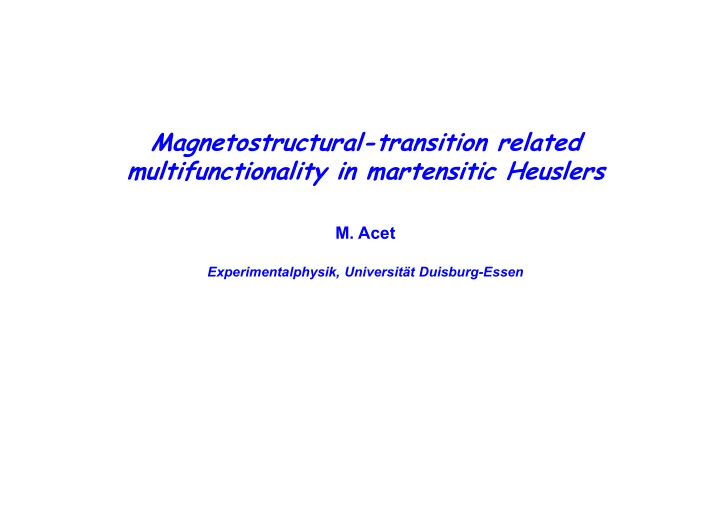

Magnetostructural-transition related multifunctionality in martensitic Heuslers M. Acet Experimentalphysik, Universität Duisburg-Essen
Outline Elemental properties of Fe and Mn Martensitic transformations and Heuslers Magnetic interactions in martensitic Heuslers
Structure of the transition elements and elements with wrong crystal structures complex cubic bcc hcp hcp bcc fcc
Allotropy in the 3d elements
Rigid band model and the Slater-Pauling curve: Valence electron concentration dependence of the magnetic moment fcc Mn fcc Fe s+d electrons 6 7 8 9 10
Structure and phase diagrams of Ni-Mn-Z (Z: Ga, In, Sn, Sb) L1 0 L2 1 14M 10M (7M) (5M) (e/a): Concentration weighted number of s+d (3d elements) + s+p (main group)
Some features of Heusler alloys Heusler alloys Shape memory Magnetic field induced Magnetocaloric effect Electron spin (nonmagnetic Structural modifications polarization martensite) (magnetic martensite) Ni-Mn-Ga Ni-Mn-Sn half metallic properties in Ni-Mn-In ferromagnetic Heuslers Ni-Mn-Ga Cu-Ni-Al Co-Mn-Al Cu-Zn-Al Ni-Mn-In
The magnetization of Ni-Mn-Z (Z: Ga, In, Sn, Sb) Why is the FM transition smeared over the temperature? Why does M(T) drop?
Extended Slater-Pauling curve
Mn-Mn separation and the martensitic transformation in Heuslers Martensitic transformation takes place for d Mn-Mn ~ 3 Å: Is there any relationship between the martensitic transformation and the onset of AF-exchange?
Complementary Neutron polarization analysis Ferromagnetic resonance
intensity q (Å -1 ) q 0 /2 q 0 sin 4 q
XYZ polarization analysis and neutron depolarization (D7/ILL) monochrometer array incident neutrons polarizer flipper Polarization analysis tot = coh + incoh + mag detector banks sample with analyzers XYZ coils D7
Neutron depolarization and the flipping ratio (R f ) analyzer/detector neutrons polarizer flipper sample OFF ON 1 0 1 n R f 1 n
Magnetization and flipping ratio Ni-Mn-Sn and Ni-Mn-Sb M s
Ni-Mn-Sn: polarization analysis Neutron depolarization Magnetic scattering
Ni-Mn-Sb: polarization analysis
T g =3.3 K
Moment configurations in austenite and martensitie c a ? c a b L2 1 14M
Summary T C (M) denotes the onset of FM and AF-like ordering Drop in M(T) caused by disappearance of FM coupling Mn and antiferromagnetism and Ms
Ferromagnetic resonance (FMR) : instrument microwave frequency : gyromagnetic ratio 0 H res = / PM H H 0 H res < / FM 0 res 0 A 0 H res AF H H ( 2 H H ) 0 res 0 A E A
Ferromagnetic resonance
The magnetization of Ni-Mn-Z (Z: Ga, In, Sn, Sb) M(T) in 5 mT M(T) in 5 T
Conclusions FM and AF correlations coexist at T > M s and beyond T C A FM correlations disappear below M s but AF short-range correlations persist down to lowest temperatures
O. Posth, M. Gruner, P. Entel Universität Duisburg-Essen T. Krenke ThyssenKrupp Electrical Steel S. Aksoy Istanbul Technical University X. Moya University of Cambridge L. Mañosa, A. Planes Universitat de Barcelona P. P. Deen Institut Laue-Langevin A. Senyshyn, S. Ener, J. Neuhaus, W. Petry TU-München & FRM II SPP 1239
Magnetic exchange constants in Ni-Mn-Sb Ni 50 Mn 40 Sb 10 L2 1 Ni Mn Sb
Ni-Mn-Sn and Ni-Mn-Sb (magnetic scattering)
Ni-Mn-Sn (coherent scattering) D7 = 4.83 Å D2B = 1.594 Å
M s and T C as a function of valence electron concentration
Pressure-dependence of magnetization Austenitic state lattice constant in Ni-Mn-In at room temperature in Ni-Mn-Z 7.87 L. Mañosa et al., APL 92, 012515 (2008). T. Krenke, Thesis (Duisburg, 2007).
Coexisting FM and AF correlations in Fe-Ni-Mn Fe 50 Ni 30 Mn 20 ( T N = 300 K) T = 300 K 1.54 ferromagnetic correlations T = 100 K T = 400 K antiferromagnetic ordering antiferromagnetic correlations
Magnetization of Ni-Mn based Heuslers A. Planes et al. J. Phys.: Condens. Matter 21, 233201 (2009)
Mn-Mn: 4.25 Å
Recommend
More recommend